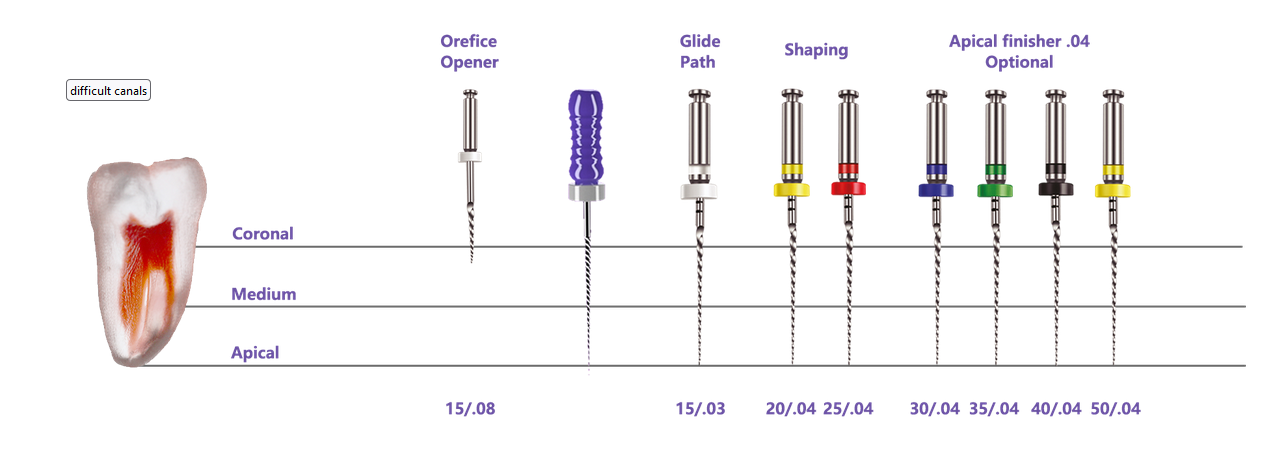

Implants



Implants


Loupes


Regeneration


Drills and screws


Surgery


Periodontology


Endodontics
One ofthe final objectives of the endodontic treatment is to preserve the biggest quantity of residual healthy dental structure because the latter plays a significant role on resistant to fracture of the treated tooth. Preservation of root dentine nowadays can be obtained by using very performing instruments, which will be very flexible and will respect the anatomy of the root canals. Recently, the instruments producing companies have concentrated their efforts not only on the modification of the design of the NiTi instruments, but also on the improvement of the characteristics of the NiTi alloy. The NiTi alloy has got three different microstructural phases, depending on the temperature: austenitic, martensitic and R-phase. The austenitic NiTi is hard and resistant, while the martensitic and R-phase NiTi are soft and ductile and can be easily deformed.
Consequently, the mechanical characteristic of the NiTi are influenced by the composition of the three phases. The conventional NiTi alloy is mostly in the austenitic phase at room temperature, but thermo mechanic treatments can keep the alloy in the martensitic phase, in R-phase or in a mixed form, altering the transformation temperature, and therefore changing the characteristics of the alloy.

Orifice Opener (15/0.8)
17mm long and with a 10mm active part that has the function to open the entrance of the canal and to remove the coronal interferences to grant the following files a straight access;
PLEX V 15/.03
that has the function to create a smooth and reproducible glide path until the working length (1,5 N.cm, 300 rpm);
PLEX V 20/.05 (2,5 N.cm, 500 rpm)
PLEX V 25/.06 (2,5 N.cm, 500 rpm)
that can be considered the first real apical finisher that shapes the canal, allowing an adequate cleansing and obturation of the canal system.
Utilize Orifice Opener inside the pulpa chamber with adequate irrigation, with 2-3 delicate pushes of 2-5mm inside and out the canal, until the coronal third has been prepared and the coronal interferences have been removed.
This step facilitate the insertion of a 10 or 0.8 K file, used for scouting of the canal, to register the working length and to verify the patency of the foramen.
Create and confirm a reproducible mechanical glide path till the working length using Plex V 15.03 with irrigation.
Regularly irrigate the canal and clean the blades from debris after removing the instrument.
In an standard canal of low-medium difficulty the PLEX V 20.05 will proceed easily along the glide path, already prepared until the working length.
Select the PLEX V 25.06 that will progressively shape the canal and will gradually proceed till the apex.

That applies the use of file Plex V 20.04 and 25.04 after the glide path is carried out and that is used for the management of complex anatomy, like curved or narrow canals. Conical 04 files are also available, until diameter #60, for the anagement of anatomy with wide foramina.
Difficult canals (narrow and curved): after completing the glide path, let the Plex V 20.04 reach the working length. Afterwards let slide the Plex V 25.04 until a resistance is found; if the file stops proceeding apically, remove it, clean the blades, irrigate, recapitulate and start again the shaping.

The prices do not include VAT
| Cena | Nazwa | Rozmiar |
|---|---|---|
| 31 EUR | NiTi files PLEX | NiTi files 15/08; 15/03, 20/04, 25/04 (21, 25, 28, 31 mm) |
| 31 EUR | NiTi files PLEX | NiTi files 15/08; 15/03, 20/05, 25/04 (21, 25, 28, 31 mm) |
| 31 EUR | NiTi files PLEX | selected size 4 pieces |
| 5 EUR | Hand use file K-files | 15-40# |
| 5 EUR | Hand use file K-files | 6#, 8#, 10#, 15# (21, 25, 28, 31 mm) PACKED WITH 6 FILES PER BOX |